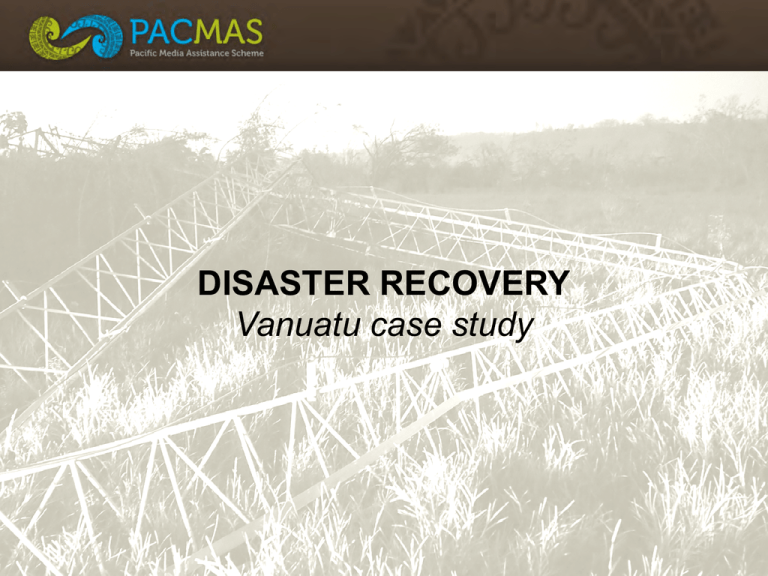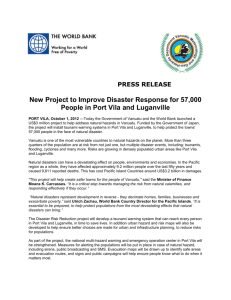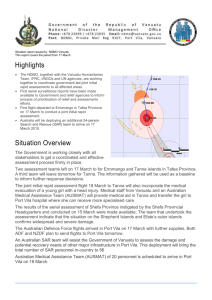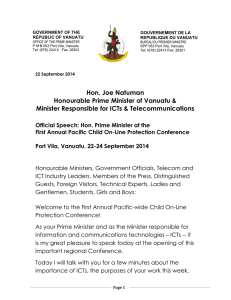DISASTER RECOVERY Vanuatu case study
advertisement

DISASTER RECOVERY Vanuatu case study http://www.realclimate.org/ Yachts in Port Vila harbour. Photo courtesy UNICEF Pacific A man escapes a dangerously high wave in Port Vila . Photo CARE Australia Homes damaged during Cyclone Pam. Photo AFP Homes flattened by TC Pam. Photo Dave Hunt-Pool/Getty Images Airforce personnel unload relief supplies. Photo Dave Hunt-Pool/Getty Images • Vanuatu considered to be the world’s most vulnerable country to natural hazards. (Due to a combination of Vanuatu’s exposure to both geophysical and hydro-meteorological hazards, and its limited financial and technical capacity to prepare for and respond to the associated risks). • Vanuatu located in the Pacific Ring of Fire and at the centre of the Pacific cyclone belt. (This results in a relatively high frequency of volcanic eruptions, cyclones, earthquakes, tsunamis, storm surges, coastal and river flooding, and landslides). • Vanuatu suffers from extreme events associated with climate variability, including sea-level and temperature extremes and droughts • Consequently, Vanuatu expected to incur, on average, US$48 million per year in losses due to earthquakes and tropical cyclones. (In the next 50 years, Vanuatu has a 50% chance of experiencing a loss exceeding US$330 million, and a 10% chance of experiencing a loss exceeding US$540 million). Source: Vanuatu Post-Disaster Needs Assessment March 2015 Disaster Risk profile of Vanuatu Between March 12 & 14, TC Pam struck Vanuatu as an extremely destructive Category 5 cyclone. Estimated wind speeds of 250km/h and wind gusts peaking at 320km/h. At approximately 11 p.m. local time on Friday March 13th, the centre of the cyclone passed east of Efate Island, which is home to the capital city of Port Vila, and then continued southward, passing just west of Erromango Island and Tanna Island. Severe and widespread damage worst on the larger islands of Tanna, Erromango, and Efate, with less damage on the smaller islands of Aneityum, Aniwa, and Futuna. The Shepherds group of islands just off North Efate suffered extensive damage. Eleven fatalities confirmed in Tafea and Shefa Provinces. An estimated 65,000 people displaced from their homes. Approximately 17,000 buildings were damaged or destroyed, including houses, schools, clinics, and other medical facilities. The tropical cyclone destroyed crops on a large scale and compromised the livelihoods of at least 80% of Vanuatu’s rural population. Source: Vanuatu Post-Disaster Needs Assessment March 2015 Tropical Cyclone PAM The total economic value of the effects caused by Tropical Cyclone Pam was estimated to be approximately US$449.4 million. Of this, US$270.9 million is attributable to damage, and US$178.5 million is attributable to loss. This is equivalent to 64.1% of GDP in Vanuatu, giving an indication of the scale of impact. Because of data limitations it’s likely these figures underestimate the total impact. Damage to social sector – Housing (32%); Tourism (20%); Education (10%) & transport (10%) Economic loss – Agriculture (33%) and Tourism (26%) Environmental losses - significant losses to ecosystem although losses not accounted within the impacts to GDP Source: Vanuatu post-disaster needs assessment March 2015 Damage & Loss Total black-out of all communications well before PAM’s centre passed the capital Port Vila where the major transmission facilities are located. All radio, television, internet & phone (mobile & landline) services downed Residents outside the capital (70% of population) unable to receive the national broadcaster’s FM/AM radio and television services many long months before PAM. Also very limited shortwave transmission. Private radio stations Capital 107FM (heard in the three major urban centres of Port Vila, Luganville & Tanna); Buzz FM (capital Port Vila only); and Crest FM (Tanna only) were forced off air by PAM Met office & NDMO turned to the two mobile phone operators to disseminate disaster warning messages to the people prior to PAM Emergency radio station set-up at Met office/NDMO in the capital and manned by VBTC forced off air well before centre of PAM struck the capital. It was back on air a day after the cyclone but with limited radius All communications with the outlying islands cut off apart from satellite phones used largely by expatriates and donor organisations Communications blackout The twisted remains of the MW mast Working to straighten an antenna at the top of the mast with no safety gear. In the immediate aftermath of the cyclone, Vanuatu Government requested PACMAS to assist with the immediate restoration of the national radio broadcast transmission service. This PACMAS support was delivered in a number of ways: a) Broadcast engineering specialists Steve White (RNZI) and Greg Britton (ABC) engaged to work with technical staff at VBTC, the NDMO and OCGIO to secure temporary fixes to the national broadcaster’s SW, MW & FM services. b) A new FM service installed on Tanna c) (a) and (b) were considered of vital importance to ensure that vulnerable communities across the country could access post-cyclone information from VanGOV & relief agencies d) PACMAS prepared a detailed list of recommendations for longer-term restoration and replacement of transmission services. This included an approximate budget for the work. e) PACMAS team in Port Vila assisted VBTC to identify and produce community service announcements, in partnership with government stakeholders. f) PACMAS team in Port Vila sent these messages to ABC International in Melbourne which produced a series of post-cyclone health and safety messages, which were broadcast regularly via Radio Australia and RNZI shortwave services. g) Solomon Islands Broadcasting (SIBC) took the initiative & broadcast messages & warnings to their neighbours in Vanuatu Restoration of broadcasting services March 9-12 Initial discussions with VanGOV reps/NDMO on likely scenarios/worst case March 13 All radio, telephone, TV & internet connectivity lost as TC Pam plunges Vanuatu into a communications blackout March 14 temporary FM service restored at NDMO head office (1km radius) – originally installed with incorrect power divider March 18 Steve White (RNZI) lands in Port Vila after aborted RNZAF flights into Port Vila on 16th & 17th Private Capital 107FM radio in Port Vila restored March 20 SW (3945kHz) put back on low power (600w) after initial repairs March 21 Further repairs to SW (3945kHz) to boost it to 1.5kw March 22 Full SW (7260kHz) put back on air after modifications and repairs March 23 Greg Britten (ABC) lands in Port Vila with parts for MW flown in from US Emergency FM service (100FM) restored to 300w & put back on air March 24 Medium wave transmitter repaired & switched on to 1.5kw March 25 Steve White returns to New Zealand March 30 VBTC crew & feeder cable depart for Tanna on board Solomons Islands police patrol boat AUKI March 31 Greg Britten (ABC) departs on an Royal Australian Air Force King Air flight with FM transmitter to Tanna April 1 Greg Britten returns to Melbourne while VBTC crew return to Port Vila on board the AUKI April 7 Television Blong Vanuatu back on air in the capital Chronology of Events TC PAM 12-13 Mar 26 days 1.5 days NDMO FM Vanuatu TV 7 Apr 14 Mar 7 days 18 days part of SW Tanna FM 20 March 31 Mar 11 days 9 days Full MW full SW 24 Mar 10 days Full NDMO FM 23 Mar Time lapses 22 Mar While PACMAS advisers were able to secure temporary fixes to transmission equipment during their short time in Vanuatu, the solutions are neither robust nor suitable for the long-term. There are also grave concerns about the durability of the present equipment and the local capacity to ensure the maintenance of these near obsolete systems. PACMAS presented its findings to the VanGOV and donors which undertook to secure the funds to implement the recommendations MF Transmitter and Power Conditioner Since the restoration work, the national SW & MW services have been regularly off air likewise with the FM station on Tanna There’s been no further confirmation from VanGOV on the transmission upgrading project for the national broadcaster Private FM stations operating out of the capital have not relied on donor or government funding to restore their services Energy Onix HF Transmitters Current situation Cyclone PAM has highlighted how fragile the mobile telephone & FM / TV networks are HF remains the only effective way of covering the islands of Vanuatu from a single location (properly maintained, the HF transmissions from Port Vila would have been unaffected by the cyclone). The public have become increasingly reliant on mobile networks (with inbuilt FM receivers). They also prefer the sound of FM radio stations. Many of the cheaper HF radios do not go below 5MHz, which is an issue for VBTC at night as they use 3945kHz. ; Absence of fresh data on how many people/communities have MF/HF radios although we suspect that in the remote areas MF/HF radios are probably still common. Need for this survey Going forward Huge task involving many sites to establish a nationwide FM network throughout Vanuatu - and even if it were, the inter-island linking will be too fragile to ever be relied upon in an emergency situation - let alone the power and tower infrastructure required, and the task of maintaining the infrastructure The failure of the existing MF and HF network before and during cyclone Pam can be linked to a large degree to a lack of maintenance of the critical VBTC transmission infrastructure – which in turn is symptomatic of a lack of financial support for the technical department a. One way to resolve this issue would be to take the critical transmission systems away from VBTC - leaving them as a content provider only, and making the NDMO directly responsible for these assets that are so vitally important to Vanuatu. b. This in turn raises a lot of questions about the mix of services required to distribute broadcast services to the islands. There are some big questions in this that need careful consideration. If the NDMO were to take control of the VBTC transmission network (in whatever form is decided) then a few business models can be considered: the Broadcast Australia model provision of HF services from off shore NDMO own and operate NDMO own and contract operations c. Other options to consider would be: the establishment of HF receiver “posts” in significant villages which would be equipped with a quality receiver, solar charged battery and good quality antenna. the general distribution of HF receivers throughout the rural community as has been done in a number of countries recently. Going forward PACMAS contracted the Secretariat of the Pacific Regional Environment Programme (SPREP) to undertake an ambitious Pacific-wide project designed to strengthen Pacific Broadcasters’ coverage during times of national disasters and emergencies. It was decided SPREP take the lead on this project under a special agreement between SPREP and the Secretariat of the Pacific Community (SPC). This project includes the following: a. seeking input and agreement on final emergency broadcasting plans from both media organisations and national disaster management organisations; b. facilitating and formalising Standard Operating Procedures between National Disaster Management Offices and National Meteorology and Hydrology system's to agree on communications procedures in times of emergency in the context of relevant national policies; c. training of media practitioners on systematic implementation and testing of Emergency Broadcasting Plan; d. Training of media practitioners on thematic areas relating to natural disasters including climate change and disaster preparedness to ensure sustained capacity Countries covered under this project were the Marshall Islands, Tuvalu, Kiribati, Solomons, Samoa, Tonga. Palau, Vanuatu and the Cook Islands PACMAS is extremely impressed with SPREP’s work in implementing this activity and is in discussions on the next phase of this project National Broadcasters’ Climate and Disaster Resilience Plan The Cyclone PAM experience highlighted the following at Vanuatu’s national broadcaster: 1. Disaster management/recovery plan not put in place 2. Need for risk assessment and management of those risks including SOP 3. Zero investment in engineering infrastructure – dependence on foreign aid 4. No replacement/upgrade transmission development plan – compatibility issues 5. Poor/incorrect installations – leads to inefficiencies and downtime 6. Issues with power supply – blows up power supply & amps, etc 7. No spares on site – long delays in getting back on air 8. No regular maintenance 9. Capacity development to strengthen technical knowledge & skills 10. Poor cooling systems in transmission room - overheating 11. No back up communication/link with NDMO/Met office 12. Need for media to strengthen relationship with OCGIO 13. No arrangements with other broadcasters to collaborate during disasters Lessons learned Looking into the future a) Greater & closer collaboration among broadcasters before, during & after disasters (awareness messages, emergency broadcasting, content sharing, etc) b) Greater & closer collaboration between telcos and content-makers/broadcasters on disaster broadcasting/awareness; c) Continued support and development of Broadcast and Climate Disaster Resilience Plans; d) Strengthen partnership between Pacific broadcasters & the Pacific Meteorological Services; e) Investment in sustainable and appropriate technical solutions that are cost effective, durable/reliable and suitable to local conditions; f) A rapid response to help restore emergency broadcasting grids for Pacific broadcasters whose transmission are damaged or destroyed in natural disasters; g) Some form of an early warning system h) A pooling system of content supplied to local broadcasters unable to gather news Fa'afetai & Tofa soifua




